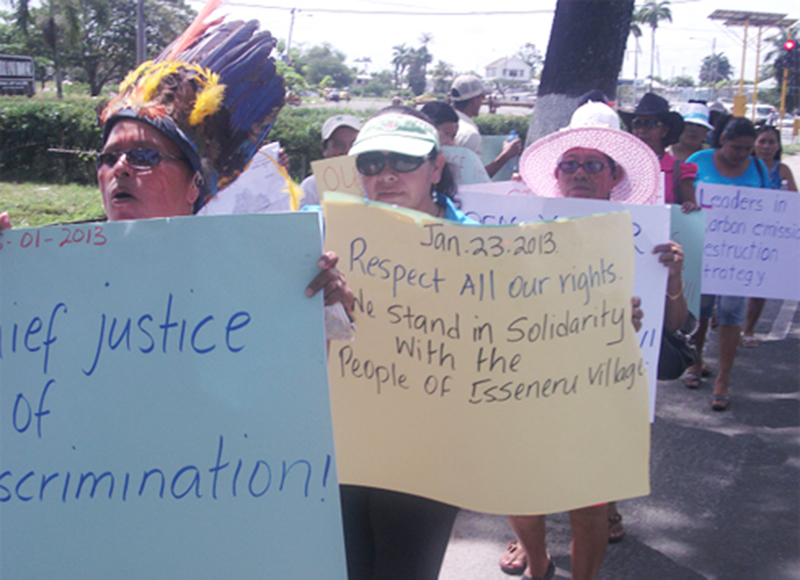The Inter-American Com-mission on Human Rights (IACHR), in a landmark ruling, has recommended that the Government of Guyana adopt the necessary measures to ensure that the Region Seven Amerindian village of Isseneru and its members receive “full reparations for the material and immaterial damages they suffered on the account of the violation of their human rights.”
“The reparations must include measures of compensation, satisfaction and any other which are deemed appropriate in accordance with the Inter-American Standards including the provision of any required health care services to community members affected by environmental pollution,” the IACHR recommended in its report.
The ruling was contained in a December 2021 report of the Commission following a case filed by the village and the Amerindian Peoples Association of Guyana back in September 2013. The judgment report remains confidential at this time but Stabroek News was able to access a copy along with two letters to the government and petitioners informing of the ruling.
In its April 20, 2022 letter to the government, addressed to Minister of Foreign Affairs Hugh Todd, the IACHR said that the case of Isseneru v the Government of Guyana (GOG) was reviewed and the report adopted by the Commission in compliance with Article 47 of the Rules of Procedure of the IACHR.
He added, “…for the Commission to be able to proceed to adopt a decision regarding its publication [of the judgment report], I request that the honourable Government of Guyana inform the Commission of the measures adopted to comply with the Commission’s recommendations and resolve the situation described within two months of the date of the transmission of the present communication.”
In the communication to the petitioners, the Com-mission informed of the timeline for government action concluding “…once this deadline has expired, the Commission shall decide whether the State has taken suitable measures and whether to publish this report.”
The IACHR is an autonomous organ of the Organization of American States (OAS) with a mission to promote and protect human rights in the American hemisphere. It is composed of seven independent members who serve in a personal capacity. Created by the OAS in 1959, the Commission has its headquarters in Washington, D.C. together with the Inter-American Court of Human Rights.
Isseneru, an indigenous community consisting largely of people from the Akawaio nation, and APA approached the IACHR on September 5, 2013, arguing that the government had violated the rights of the community and its members to property, equality before the law, justice and a fair trial, to the protection of mothers and children, to the preservation of health and wellbeing, and to enjoy the benefits of culture. All of these rights were protected by several Articles of the America Declaration on the Rights and Duties of Man.
The petitioners submitted that the state failed to “adequately recognize, respect and protect the community’s territorial rights” when it granted mining permits on ancestral lands with prior consultation or consent. They also told the Commission that the government failed to protect the community from the negative impacts of mining adding that the state could not provide effective judicial remedies to counter the violation of their rights.
Based on the report, IACHR informed both the government and petitioners, on June 6, 2017, that the application was covered by Article 36(3) of the Rules of Procedure which states “…the Commission may open a case but defer its treatment of admissibility until the debate and decision on the merits. The decision shall be adopted by a reasoned resolution of the Commission, which will include an analysis of those exceptional circumstances. The exceptional circumstances that the Commission shall take into account will include the following: a. when the consideration of the applicability of a possible exception to the requirement of exhaustion of domestic remedies would be inextricably tied to the merits of the matter; b. in cases of seriousness and urgency, or when the Commission considers that the life or personal integrity of a person may be in imminent danger; or when the passage of time may prevent the useful effect of the decision by the Commission.”
Admissibility
Both parties were granted time to make submissions on the merits of the petition. However, the state did not submit observations on the admissibility or merits of the petition event though it had ample procedural opportunities to do so, according to the report.
Nevertheless, the state did submit two detailed observations on the associated request for precautionary measures, some of which were deemed relevant to the issues of admissibility and merits of the petition.
In arguing its case, the petitioners submitted that the existing legal mechanism for the titling of indigenous lands in Guyana is inadequate. They argue that Petitioners claim that the Guyanese legal system does not recognize the pre-existence of ancestral territorial rights, but rather visualizes these rights as grants made by the State, which are not inherent or grounded on their history, culture or tradition.
The petitioners told the Commission that the system is discriminatory, and in their view, racial discrimination is evident in relation to the lack of adequate recognition and
protection of territorial indigenous rights. Moreover, they claim that failure to recognize and protect these rights threatens their survival as distinct cultural and territorial entities.
They allege that Guyana lacks a procedure in its legislation to title, delimit and demarcate indigenous lands and that the legal mechanism in place gives an excessive level of discretionary powers and liberty to the Ministry of Amerindian Affairs in the process of deciding on whether, and to what extent, indigenous lands should be “granted” to Amerindian Villages and Communities.
Isseneru and the APA submitted that the state has no obligation to issue indigenous territorial property titles and the decision is merely discretionary, regardless of any evidence that may be presented. Additionally, the Commission heard that the existing legislation restricts indigenous participation, territorial rights and self-governance rights on the basis of whether and when the state has granted rights to the respective community.
The Commission was told that the legal system establishes a discriminatory differentiation between titled and untitled communities, insofar as the latter are unable to exercise their territorial rights in any way. Additionally, both the Amerindian Act and Lands Act provisions do not apply to untitled communities nor to the untitled lands of titled communities. The petitioners also identified the lack of mechanisms which to return ancestral lands to the indigenous communities which have been deprived of them.
They also argued that the legal system subordinates indigenous territorial rights to private property and to the interests and rights of miners and other economic actors.
The appeal to the IACHR partly stemmed from two High Court rulings against the village’s objections to mining projects. Back in 2013, Justice Diana Insanally made orders granted to miner Joan Chang against the Isseneru Village Council and the Guyana Geology and Mines Commission (GGMC) binding. Members of the Village Council had claimed that the mining company was mining on titled lands without the council’s permission under the Amerindian Act and despite subsequent Cease Work Orders (CWOs) issued by the GGMC mining officer. Justice Insanally pointed out in her ruling that by virtue of Chang being granted a licence to mine prior to the coming into operation of the Amerindian Act of 2006, the Village Council had no authority to stop the operation and the GGMC no authority to issue the CWOs.
On August 13, 2008, a similar judgment was made in the High Court in the case of Lalta Narine v Isseneru.
In their petition to the IACHR, Isseneru argued that its application for resolution of the territorial claim was rejected by the Minister of Amerindian Affairs “on the subjective grounds that it was too large.” They noted that the titled land granted to Isseneru contains a provision that excludes and excises prior property rights from the title.
“…the petitioners claim that Guyana has violated the territorial rights of the Isseneru community and its members, as well as their right to equality before the law, their rights to health and welfare, their right to enjoy the benefits of culture, and the rights of mothers and children -the latter particularly affected by the pollution of rivers with mercury. They also assert that their rights to a fair trial and due process of law have been violated by the State, given the Guyanese judiciary’s failure to protect their territorial rights and provide them with an effective remedy before the Courts to seek and obtain protection for their rights, both in relation to the titling of their ancestral lands and to the protection of miners’ rights” the report stated.
It was identified that in the two observations, the state contended that “the allegations set out in the petition are ill-founded, grossly misleading, prejudicial to the rights of the Amerindian peoples and disrespectful in denying the progress that Amerindian peoples have made.”
The state held that Isseneru villagers have abandoned their traditional ways and customs by engaging in a “cash economy” as opposed to subsistence while denying that mining threatens the livelihood of the community.
“The State also argues that the Isseneru community members have lost their traditional culture in aspects such as their building materials, their architecture and their farming systems. The State particularly emphasizes that most of the members of the community have converted to Christianity, and therefore do not preserve an ancestral spiritual connection to their territory,” the report added.
Conclusions and recommendations
After reviewing the petition, the IACHR concluded that the state is responsible for at least 16 violations of the rights of the Isseneru community and its members. It identified that the right to collective territorial property under Article XXIII of the America Declaration on the Rights and Duties of Man was violated when the Amerindian Act failed to recognize the pre-existence of indigenous territorial rights, did not obligate the state to grant indigenous communities title to ancestral territory.
The IACHR also added that Article XXIII, which states “Every person has a right to own such private property as meets the essential needs of decent living and helps to maintain the dignity of the individual and of the home,” was further violated when the Amerindian Act conferred the Minister of Amerindian Affairs an “overboard and excessive degree of discretionary powers on whether to grant property title to indigenous communities…”
The Commission found that the state failed to grant Isseneru title over its entire ancestral territory despite the community demonstrating that it is a primarily Akawaio village, that it is set within Akawaio territory and, among others, it needs the full extent of the territory to pursue livelihood and survival.
The Commission concluded that the community’s right to equality before the law was violated and the title deeds granted along with the judgments of the court placed private property rights and economic interests of third parties over the protection of indigenous territorial property.
The state violated “…the right to indigenous collective territorial property of the Isseneru community and its members because the mining operations developed by Messrs. Lalta Narine and Joan Chang were not the subject of prior consultations, socio-environmental impact assessments, or reasonable benefit-sharing mechanisms before they began implementation.
“The right to collective territorial property, and its interconnected rights to health, food, water, a healthy environment and cultural integrity, because in relation to the untitled lands -within Isseneru’s ancestral territory the State has granted mining permits which have not been consulted, assessed in their environmental and social impacts, nor been the matter of reasonable benefit sharing. Moreover, the Isseneru community’s right to territorial property has been disregarded because it is legally powerless in relation to its untitled lands under Guyanese law. The IACHR highlights that, if any permits, concessions or licenses are issued for mining, forestry or any other extractive activity within the untitled parts of Isseneru’s ancestral territory before said territory is duly titled, demarcated and delimited in its full extent, the State of Guyana would incur in a violation of international law, in particular of the right to collective property under Article XXIII of the American Declaration.”
The Commission also concluded that the community’s rights to health, water, food and a healthy environment were violated by the negative impacts of mining in the community particularly contamination of waterways.
As a result of the plethora of violations of the community’s human rights, the IACHR recommended that government “…amend its legislation in order to secure that the provisions of the relevant Acts and regulations related to indigenous territorial property are in harmony with the American Declaration, in accordance with international law according to the present merits report.”
The government has also been advised to adopt the necessary measures to support Isseneru and its members in their duty to preserve and protect the environment, particularly in relation to the mining operations that the community undertake on its ancestral lands.
Back in 2013, the village had staged a protest outside the Office of the President (OP) to voice their dissatisfaction with the two court rulings.
“The Best Act?? You lied to us!” “Our land, Our life,” and “Respect all our rights,” were among the messages on placards carried by protestors, some of whom demonstrated with their faces painted.









